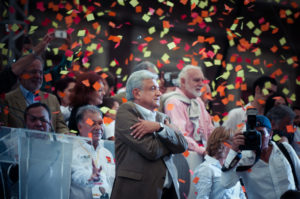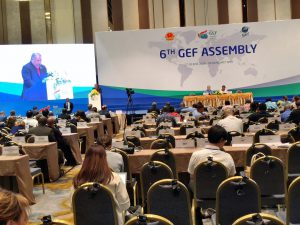India’s water crisis is now official. The government’s own think tank the National Institution for the Transformation of India (NITI) Aayog – successor to the country’s Planning Commission – says 600 million Indians face high-to-extreme water stress.
This is the first time that the government has officially acknowledged and given details of the country’s water crisis, and it shows a situation even worse than feared by environmentalists, who welcomed the transparency.
But the decision to go public with the water crisis was described as “unhelpful” by former bureaucrats who have dealt with water issues throughout their lives. Speaking on condition of anonymity, one of them pointed out that the crisis was not of water resources but of water management.
He felt that by publicising such a dire resource crunch, the government was trying to forestall criticism on water management, an issue that is likely to play an important role as India gears up for the next elections to Parliament, due by May 2019.
India’s water crisis
First, some of the numbers: about 200,000 people die every year due to inadequate access to safe water and 21 major cities are expected to run out of groundwater as soon as 2020, affecting around 100 million people, the think tank’s new report states. 75% of households do not have drinking water at home, 84% rural households do not have piped water access, and 70% of India’s water is contaminated, with the country currently ranked 120 among 122 in the water quality index.
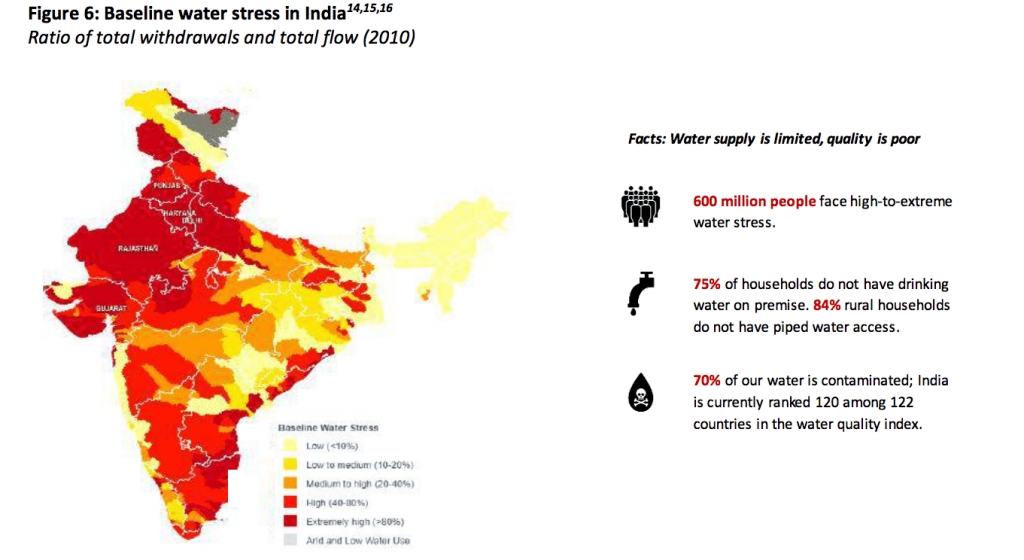
Droughts are becoming more frequent, creating severe problems, especially because approximately 53% of agriculture in India is rainfed. Perhaps unsurprisingly, interstate disagreements over water are on the rise, with seven major disputes raging right now.
The crisis is going to get worse. By 2030, the country’s water demand is projected to be twice the available supply, implying severe water scarcity for hundreds of millions and an eventual loss of around 6% of the country’s GDP.
The dire data was announced by Amitabh Kant, NITI Aayog CEO. It was gathered from state governments as the think tank developed a Composite Water Management Index (CWMI) over the last two years. The index aims to establish a clear baseline and benchmark for state-level performance on key water indicators; uncover and explain how states have progressed on water issues over time; and identify areas for deeper engagement and investment by states.
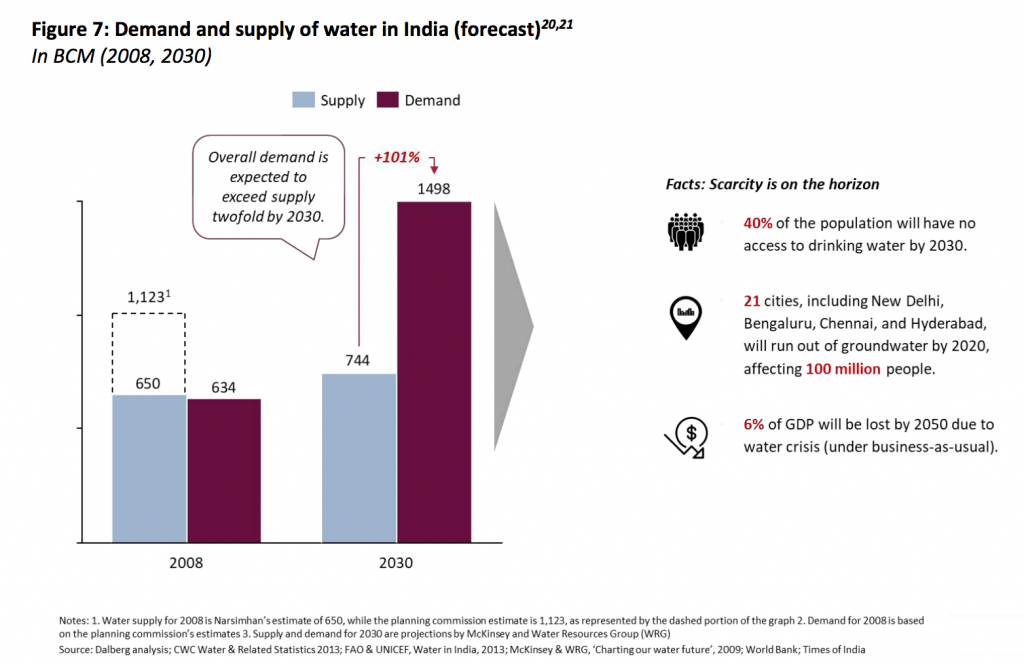
India’s groundwater depletion
Under the Indian Constitution, water is a state subject, but the only groundwater regulatory agency – set up only after an order from the Supreme Court – is under the central government. India is now the biggest groundwater user in the world, and the most serious problem now is unsustainable use of groundwater, coupled with neglecting or even destroying recharge systems. The regulatory agency has been almost totally non-functional since it was set up in 1997.
The NITI Aayog database says 54% of wells in India are declining in level due to unsustainable withdrawals for irrigation. “States need to establish strong regulatory frameworks for managing and using groundwater,” it concludes, through “market-based interventions, such as impact bonds, that can also be explored to incentivise community institutions and users to recharge groundwater.” This has been roundly criticised by water rights activists, who fear that such bonds will enable commercial farming companies – especially those who have vineyards and the large sugarcane farmers – to draw even more groundwater at the expense of smallholder farmers.
With 80% of water in India being used for irrigation, the think tank says most states are doing well on utilising irrigation potential, but “maintenance of assets is poor.”
It says, “States need to implement robust participatory irrigation management measures that allow motivated and knowledgeable local users to control fee collection, use monitoring, and O&M (operation and maintenance).” Reacting to this, Himanshu Thakkar of the South Asia Network on Dams, Rivers and People said, “This has not worked and won’t. Participation needs to start at decision making level about water resources development.”
Of the 24 states from which data was collected, 20 have established a legal and regulatory framework for participatory irrigation management through Water User Associations (WUAs), but “progress on the ground is inadequate with 10 states having WUAs involved in maintenance activities in less than 20% of the irrigation command area. The report calls for states to establish WUAs across the majority of irrigated areas and “ensure they are allowed to retain a significant portion of irrigation fees and are thus empowered to govern local irrigation systems.”
No access to clean water
The database shows that provision of drinking water to villages has improved from 2015-16 to 2017-18, but states in the Himalayas and in North Eastern India lag behind.
Most states report a high percentage of urban population with access to drinking water, except for north-eastern and eastern parts of the country, which report less than half of the urban population having access.
Throughout India, the big problem is that “water quality remains a major issue, with several populous states reporting no reduction in quality incidents. State governments can support entrepreneurs in piloting and scaling promising decentralised technologies for measuring and improving water quality,” NITI Aayog suggests. In response, environmentalists suggest that the government will do much better if it makes existing state and central pollution control boards effective.
Waste water treatment capacity and actual treatment vary widely, but around 70% of states treat less than half of their waste water. “Urban access can be improved by reducing the approximately 40% of water lost due to leakages in urban areas through smart technologies such as sensors,” says the think tank. “Further, building treatment capacity can enable reuse of water, thereby increasing the utility gained out of every drop.”
Water pricing
NITI Aayog’s big recommendation for urban water supply is to price it where it is not being priced, and price higher above various consumption levels, thus subsiding the poorer users. Water supply pricing does follow this pattern in cities where it is priced, but in most cities, there is no efficient metering or fee collection. Trying to enforce that may be a political hot potato.
Overall, the think tank believes better collection of data, centre-state and inter-state cooperation are “some of the key levers that can help address the crisis.” This is where it faces the maximum criticism from activists.
Thakkar said, “It is surprising that NITI Aayog and the current government, which have been advocating suicidal projects such as interlinking of rivers and large dams, now says it needs better data. On what basis have they been taking their decisions all this time? As for centre-state and inter-state cooperation, most state governments are just as responsible for pushing destructive projects as the centre, so I don’t see how that can help.”
“The exercise by NITI Aayog is far from transformative,” the activist added. “Like the water data in India, it lacks rigour, quality, reliability, transparency of process and most importantly, forthright honesty.”
See also: Will Covid-19 force India to face up to its water crisis?
![<p>Rajasthan during a drought. The government hopes a crisis narrative around water will deflect criticism away from poor water management [image by Knut-Erik Helle]</p>](https://dialogue.earth/content/uploads/2016/11/Water-woman-drought-rajasthan.jpg)

![Under Narendra Modi, there has been a renewed focus on building large dams and diverting rivers [Photo shows the Brahmaptura by: INDIA-ACTED-SAMISIVA-130]](https://dialogue.earth/content/uploads/2017/11/37440237726_e8fd1aa6d6_k-300x199.jpg)

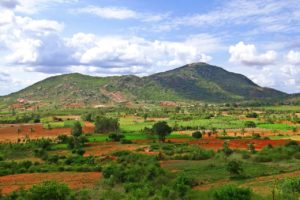

![Aerial view of the Mekong Delta often referred to as the rice bowl of Vietnam [image by: Gareth Bright]](https://dialogue.earth/content/uploads/2018/02/Vietnam1-300x200.jpg)

